Question
(a) State what is represented by an electric field line.
(b) Two point charges P and Q are placed \(0.120\) m apart as shown in Fig. 4.1.
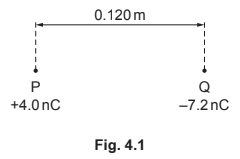
(i) The charge of P is \(+4.0\) nC and the charge of Q is \(–7.2\) nC.
Determine the distance from P of the point on the line joining the two charges where the electric potential is zero.
(ii) State and explain, without calculation, whether the electric field strength is zero at the same point at which the electric potential is zero.
(iii) An electron is positioned at point X, equidistant from both P and Q, as shown in Fig. 4.2.
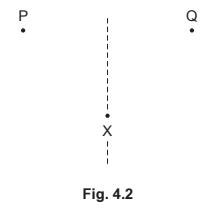
On Fig. 4.2, draw an arrow to represent the direction of the resultant force acting on the electron.
Answer/Explanation
Ans:
(a) direction of force
force on a positive charge
(b) (i) \(V\) = \(\frac{Q}{4\pi \varepsilon _{0}r}\)
\(\frac{4.0 \times 10^{-9}}{4\pi \varepsilon _{0}x} + \frac{-7.2\times 10^{-9}}{4\pi \varepsilon _{0}(0.120 – x)}\)
\(4(0.120 – x)\) = \(7.2\) x
x = \(0.043\) m
(ii) fields are in the same direction so no
(iii) straight arrow drawn leftwards from X in direction between extended line joining Q and X and the horizontal
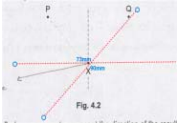
Question
(a) State an expression for the electric field strength E at a distance r from a point charge Q in a vacuum.
State the name of any other symbol used.
(b) Two point charges A and B are situated a distance \(10.0\) cm apart in a vacuum, as illustrated in Fig. 6.1.
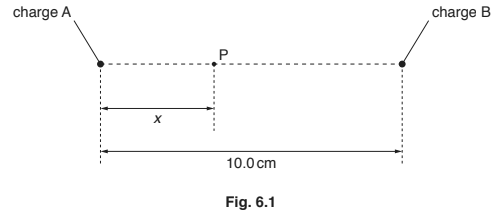
A point P lies on the line joining the charges A and B. Point P is a distance x from A.
The variation with distance x of the electric field strength E at point P is shown in Fig. 6.2.
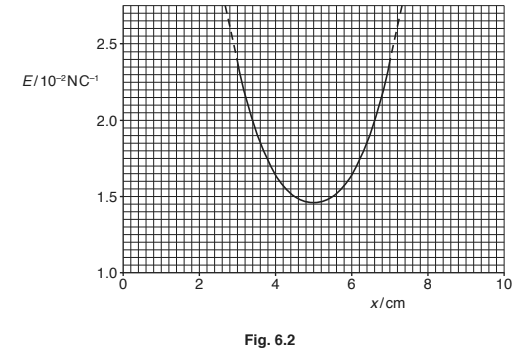
State and explain whether the charges A and B:
(i) have the same, or opposite, signs
(ii) have the same, or different, magnitudes.
(c) An electron is situated at point P.
Without calculation, state and explain the variation in the magnitude of the acceleration of the electron as it moves from the position where x = \(3\)cm to the position where x = \(7\)cm.
Answer/Explanation
Ans:
(a) \( (E =) Q / 4 \pi ε_{0}r^{2}\)
where \(ε_{0}\) is permittivity (of free space)
(b) (i) field does not change direction/field does not become zero
so (charges have) opposite (sign)
(ii) minimum is at the midpoint (between the charges)
so (magnitudes are the) same
(c) force = field strength \(\times\) charge and force = mass \(\times\) acceleration
or
acceleration is proportional to field strength
(from x = \(3.0\) cm) to x = \(5.0\) cm: acceleration decreases
at x = \(5.0\) cm: acceleration is a minimum
